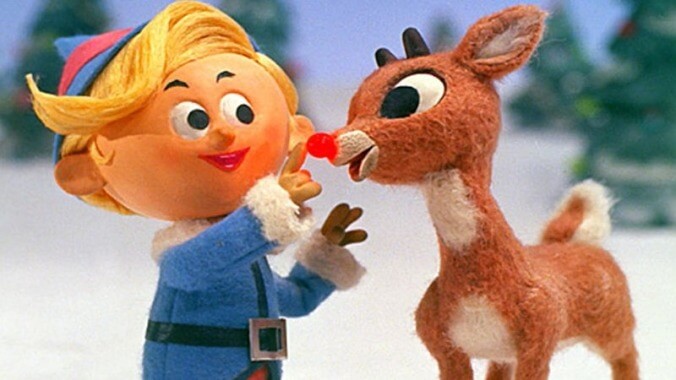10 entry points to Rankin/Bass’ enchanted holiday world
Rankin/Bass Productions effectively owned the holiday TV season from the late ’60s to the early ’80s


Of the five vintage TV Christmas specials that still command an annual network airing—Rudolph The Red-Nosed Reindeer, A Charlie Brown Christmas, How The Grinch Stole Christmas, Frosty The Snowman, and Santa Claus Is Comin’ To Town—three resulted from the creative partnership between Arthur Rankin Jr., and Jules Bass. Originally working under the auspices of Videocraft International, Ltd., Rankin/Bass Productions effectively owned the holiday TV season from the late ’60s to the early ’80s, averaging one new Christmas special per year, often drawing from the same pool of talent: composer Maury Laws (who teamed with Bass for the programs’ music), screenwriter Romeo Muller, voice actor Paul Frees, and production designer Paul Coker. Bearing a handmade style that grew more polished with each passing year, the Rankin/Bass specials made fantastical additions to Christmas lore, crafting origin stories for Rudolph and the like while cannily filling in the spaces between the measures of treasured carols.
But it wasn’t all snowflakes and candy canes for Rankin and Bass: While its outsourced animation elves were putting the finishing touches on the studio’s latest Christmas offering, the Rankin/Bass brain trust dreamed up programming to fill out TV schedules during the other 11 months of the year. Still, with their celebrity narrators and distinctive visual flourishes, specials like The Mouse On The Mayflower and Here Comes Peter Cottontail project a basic Rankin/Bass-ness, even if they never earned the cachet or perennial airtime of their Yuletide contemporaries.
Yet, for their abundant imagination and astounding creative efficiency, Rankin and Bass remained one of television’s consummate partnerships until it sundered amid the post He-Man glut of Rankin/Bass action cartoons like ThunderCats, SilverHawks, and TigerSharks. The studio’s legacy is a tricky one, built on ideas and concepts that had already proven successful in song, literature, or film. Rankin/Bass productions possessed a childlike desire to extend a favored story beyond the original author’s “happily ever after,” populating other creatives’ fictional worlds with Yukon Corneliuses and Miser Brothers.
That playing-in-someone-else’s-sandbox approach puts the studio’s faithful (if condensed by necessity) pair of made-for-TV J.R.R. Tolkien adaptations—The Hobbit and The Return Of The King—in stark contrast. In their years as collaborators, Rankin and Bass put Johnny Marks and Phyllis McGinley on an equal plane with Tolkien and L. Frank Baum; any additions they brought to the table should be viewed less as “improvements” and more as acts of translation. Maturing alongside the medium itself, Rankin/Bass’ television efforts trace a brief history of updating traditions—holiday and non-holiday alike—for a new mode of storytelling. No wonder the strongest of those efforts still find a way to come back every December

This article originally ran in 2012.Of the five vintage TV Christmas specials that still command an annual network airing—, , , Frosty The Snowman, and Santa Claus Is Comin’ To Town—three resulted from the creative partnership between Arthur Rankin Jr., and Jules Bass. Originally working under the auspices of Videocraft International, Ltd., Rankin/Bass Productions effectively owned the holiday TV season from the late ’60s to the early ’80s, averaging one new Christmas special per year, often drawing from the same pool of talent: composer Maury Laws (who teamed with Bass for the programs’ music), screenwriter Romeo Muller, voice actor Paul Frees, and production designer Paul Coker. Bearing a handmade style that grew more polished with each passing year, the Rankin/Bass specials made fantastical additions to Christmas lore, crafting origin stories for Rudolph and the like while cannily filling in the spaces between the measures of treasured carols.But it wasn’t all snowflakes and candy canes for Rankin and Bass: While its outsourced animation elves were putting the finishing touches on the studio’s latest Christmas offering, the Rankin/Bass brain trust dreamed up programming to fill out TV schedules during the other 11 months of the year. Still, with their celebrity narrators and distinctive visual flourishes, specials like The Mouse On The Mayflower and Here Comes Peter Cottontail project a basic Rankin/Bass-ness, even if they never earned the cachet or perennial airtime of their Yuletide contemporaries.Yet, for their abundant imagination and astounding creative efficiency, Rankin and Bass remained one of television’s consummate partnerships until it sundered amid the post He-Man glut of Rankin/Bass action cartoons like ThunderCats, SilverHawks, and TigerSharks. The studio’s legacy is a tricky one, built on ideas and concepts that had already proven successful in song, literature, or film. Rankin/Bass productions possessed a childlike desire to extend a favored story beyond the original author’s “happily ever after,” populating other creatives’ fictional worlds with Yukon Corneliuses and Miser Brothers.That playing-in-someone-else’s-sandbox approach puts the studio’s faithful (if condensed by necessity) pair of made-for-TV J.R.R. Tolkien adaptations—The Hobbit and The Return Of The King—in stark contrast. In their years as collaborators, Rankin and Bass put Johnny Marks and Phyllis McGinley on an equal plane with Tolkien and L. Frank Baum; any additions they brought to the table should be viewed less as “improvements” and more as acts of translation. Maturing alongside the medium itself, Rankin/Bass’ television efforts trace a brief history of updating traditions—holiday and non-holiday alike—for a new mode of storytelling. No wonder the strongest of those efforts still find a way to come back every December